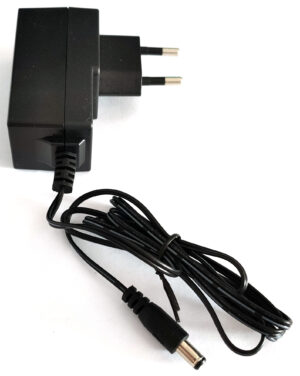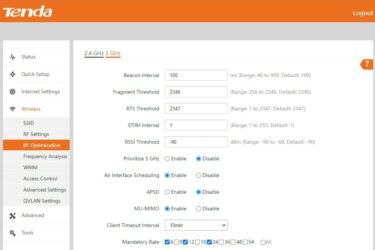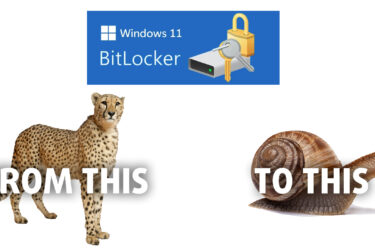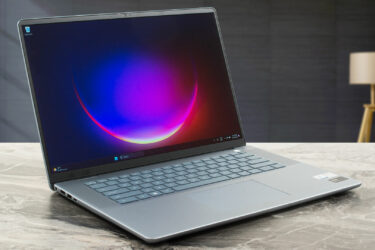Tenda i24 AC1200 Wave 2 Gigabit Access Point review – capable device and reasonable price in one place
 No matter if you are a power user or you just need an Internet connection for daily routine tasks like mail checking, Web browsing, watching videos, etc, sometimes a single router with Wi-Fi functionality isn’t enough. Especially when the router is in a spot that is surrounded by thick brick walls – in this scenario, the connection can be unstable while the download speed can be too slow for normal usage.
No matter if you are a power user or you just need an Internet connection for daily routine tasks like mail checking, Web browsing, watching videos, etc, sometimes a single router with Wi-Fi functionality isn’t enough. Especially when the router is in a spot that is surrounded by thick brick walls – in this scenario, the connection can be unstable while the download speed can be too slow for normal usage.
The other problem that is bothering a lot of home users is when multiple devices are connected to the router at the same time – in this case, you can experience slow Internet speed, sudden disconnects, or even the network can become unreachable. This can be quite annoying and buying a new and better router may not be the ultimate problem solver.
One of the most wallet-friendly solutions is an access point. Yes, these things are cheaper compared to a mesh system (well, in most cases), but at the same time, if you know what you’re doing (ergo, you have experience with this kind of device) you can enjoy a fast and reliable connection without spending too much money.
The gadget that we’re going to review today is the Tenda AC1200 Wave 2 Gigabit Access Point and we got the i24 model. There are i25 and i27 models, but the i24 variant looks like the price / performance champion of the bunch when it comes to home (or small office) usage – its maximum wireless user capacity is good (100) and its coverage is 300m² which is again a good achievement for a device that has a modest price tag. Actually, these specs can be even enough for a small office so this Tenda device seems like a capable access point that doesn’t cost too much but as always, we have to test it first before making any conclusions.
You can check the current price of Tenda i24 AC1200 Wave 2 Gigabit Access Point here: Buy from Amazon.com (#CommissionsEarned)
Contents
Specs Sheet
| AC1200 Wave 2 (i24) | |
|---|---|
Wireless Standard | 802.11a/b/g/n/ac(wave2) |
Ethernet Interface | 1 x 10/100/1000 Base TX |
Data Rate | 2.4GHz: 300Mbps 5GHz: 867Mbps |
| Antenna | 2.4GHz: 2 x 4dBi 5GHz: 2 x 4dBi |
Power supply standard | 802.3af/at and DC: 12V 1A |
Frequency Band | 2.4GHz, 5GHz |
| Max Transmit Power | 2.4GHz: 23dBm 5GHz: 23dBm |
| Sensitivity | 802.11b :-93 dBm 2.4 GHz 802.11n (MCS7):-73dBm 5 GHz 802.11a :-93 dBm 5 GHz 802.11n (MCS7) :-74 dBm |
Maximum Power Consumption | <11.5W |
| Basic Features | Adjustable power transmit Access control MU-MIMO WEP WPA2 |
| Special Features | VLAN tagging for SSID |
| Others | Hide SSID AP isolation RSSI Threshold Diagnostics |
| Package Dimensions | 9.3 x 7.4 x 2 inches |
What’s in the box?
Well, nothing too fancy here, that’s a cost-effective device. We got a normal and compact box that contains the access point itself (protected by semi-transparent cloth), a power adapter, and manuals. If you want to place the device on a wall, the package contains all the needed tools – a mounting bracket, plastic mounters, plastic nuts, and screws.
Design and construction
The design of this Tenda device is clean and modern. Expectedly, we have a plastic construction and the weight is on the low side. The access point isn’t too big, but it’s not the most compact one out there, some people may probably mistake it for a standard router. If the device is too big for your desk, just place it on the wall using the mounting bracket.
Installation, Features, Setup, and Testing
The good news is, you don’t need an external app for setting up this access point. The installation is pretty straightforward – you need a LAN cable – one end goes to your computer and the other end should be plugged in the Tenda i24. After that, you have to open “Network And Sharing Center” and follow the manual’s instructions. Then, you have to use the Web interface, open your browser and enter the following address in the address bar – 192.168.0.254. Voila, now you have access to the access point and you can fine-tune the settings.
One important thing – you have access to 2.4 GHz and 5GHz networks and they are available at the same time (by default). You have to manually set up a password for both networks (Quick Setup – Security Mode), if you do that for just one of them, the other network will be exposed.
Before deep-diving into the other settings, probably most users should change the username and password for accessing the device because as always, they are set to “admin / admin”. After doing this, you can browse the plethora of options. Sure, you don’t have to enable or set up everything on the menus but the tabs are well organized and the options are named adequate and understandable. Most of the settings are available for both 2.4 GHz and 5GHz bands so keep an eye on it because you can unintentionally set up the wrong network.
You have a lot of things for modifying – you can set up the max number of clients, the security mode, you can change the channel bandwidth and the transmitting power. You can enable or disable MU-MIMO (but this should be left turned on in most cases), you can have a look at the Frequency Analysis (from there you can see how many SSIDs are connected and their total channel usage) and the Access Control is one of the most important functions for the advanced users.
This setting lets you blacklist or whitelist a MAC address of a device – let’s say that you don’t want a particular machine to have access to your network and you can simply blacklist its MAC address and that’s all. You can do things the other way around – for additional security, you can whitelist only some trusted devices by entering their MACs in the Web UI and no one else can’t use your network.
In addition, you can set up the QVAL settings (of course, if you want to use it, most home users probably will not touch this option) and the Maintenance tab is very useful because from there you can execute commands like Reboot, Reset, Firmware Upgrade, you can backup or restore your settings (it’s good to make a backup before resetting the device or when you want to upgrade the firmware), and you can even turn off the LED indicator.
After we finish with the initial setup, we connected several devices (smartphones and laptops) to the access point and everything was fine – the network signal was full and we didn’t experience any connection problems even when one of the laptops was behind a thick wall and the access point was in the other room. So, yes, Tenda i24 AC1200 Wave 2 Gigabit Access Point just gets the job done.
Verdict
 Tenda i24 AC1200 Wave 2 Gigabit Access Point is a good choice if you don’t want to spend too much money on this kind of gadget. If you have problems related to unstable connections in your home or in the (small) office, this device can save you a lot of headaches without stretching your wallet too much.
Tenda i24 AC1200 Wave 2 Gigabit Access Point is a good choice if you don’t want to spend too much money on this kind of gadget. If you have problems related to unstable connections in your home or in the (small) office, this device can save you a lot of headaches without stretching your wallet too much.
The i24 model is rich in features which is great given the fact that it’s not positioned as a high-end one. First of all, it supports 2.4 GHz and 5GHz bands and that leads to better compatibility with older computers and smartphones. One of the features that most home users can appreciate is the Guest Network – this separate network can be used by other users without giving to them the password of your main network. This can be handy for house parties and birthdays.
Specs-wise, up to 100 users can be connected to the wireless network at the same time which (probably) is just fine even for a small office. Again, the 300m² coverage should be enough for most homes. The more advanced users can even add VLAN tags for SSIDs for additional security.
Because of the MU-MIMO (Multi-User Multiple-Input Multiple-Output) feature, the access point can operate with multiple devices at the same time by using multiple antennas. This leads to a more efficient and smart balanced network load (and improved Wi-Fi speed) when a lot of devices are using one network.
Tenda i24 AC1200 Wave 2 is an access point that doesn’t cost a lot of money but it has a lot to offer. It can be a real problem-solver for home and small office usage where many users want to connect to the same network. The Web UI is rich in features and it offers a good amount of security options like blacklisting particular MACs or VLAN tags for SSIDs.
You can check the current price of Tenda i24 AC1200 Wave 2 Gigabit Access Point here: Buy from Amazon.com (#CommissionsEarned)
Pros
- Good price tag
- Has a Gigabit LAN port
- The installation is user-friendly
- Detailed manual
- The Web UI has tons of options
- Supports both 2.4 GHz and 5GHz bands
- Good amount of security options
- Stable connection when multiple devices are connected at the same time
Cons
- Can be a bit more compact
- Lacks an Ethernet cable in the box























